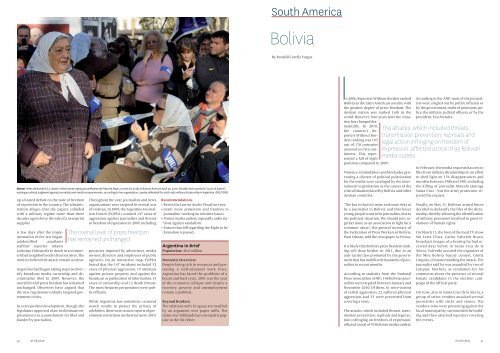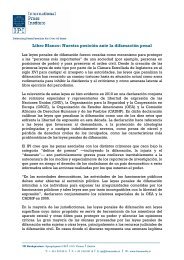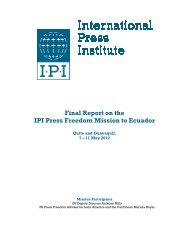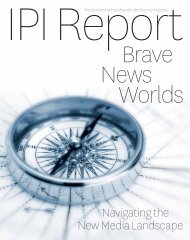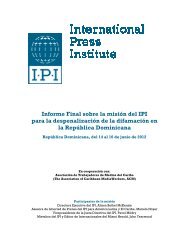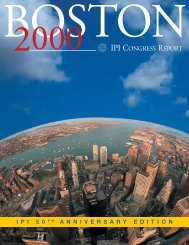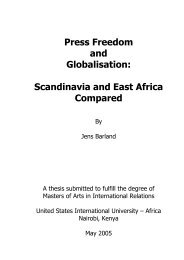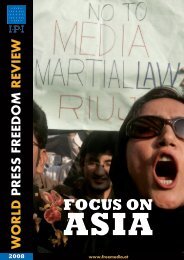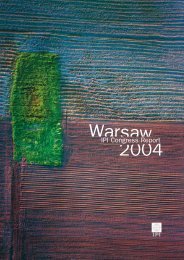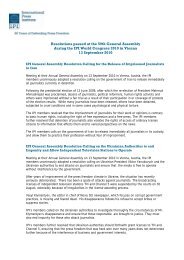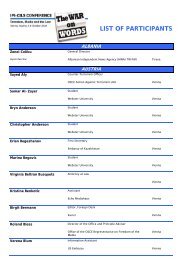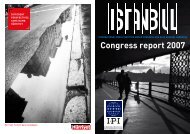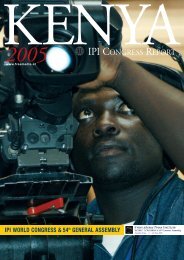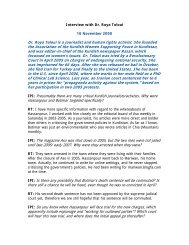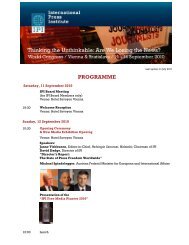FOCUS ON THE AMERICAS - International Press Institute
FOCUS ON THE AMERICAS - International Press Institute
FOCUS ON THE AMERICAS - International Press Institute
You also want an ePaper? Increase the reach of your titles
YUMPU automatically turns print PDFs into web optimized ePapers that Google loves.
Above: Hebe de Bonafini (L), leader of the human rights group Madres de Plaza de Mayo, arrives for a rally in Buenos Aires on April 29, 2010. Bonafini led a symbolic "court of justice",<br />
making an ethical judgment against journalists and media companies who, according to her organization, openly defended the 1976-1983 military dictatorship in Argentina. (REUTERS)<br />
up a heated debate on the state of freedom<br />
of expression in the country. The administration<br />
alleges that the papers colluded<br />
with a military regime more than three<br />
decades ago to force the sale of a newsprint<br />
supplier.<br />
A few days after the implementation<br />
of the law began,<br />
unidentified assailants<br />
stabbed reporter Adams<br />
Ledesma Valenzuela to death in an impoverished<br />
neighborhood in Buenos Aires. The<br />
motives behind the attack remain unclear.<br />
Argentina had begun taking steps to diversify<br />
broadcast media ownership and decriminalize<br />
libel in 2009. However, the<br />
overall level of press freedom has remained<br />
unchanged. Observers have argued that<br />
the new regulations unfairly targeted government<br />
critics.<br />
In a rare positive development, though, the<br />
legislature approved a law to eliminate imprisonment<br />
as a punishment for libel and<br />
slander by journalists.<br />
50 IPI REVIEW<br />
Throughout the year, journalists and news<br />
organizations were targeted in several acts<br />
of violence. In 2009, the Argentine Journalism<br />
Forum (FOPEA) counted 147 cases of<br />
aggression against journalists and threats<br />
to freedom of expression in 2009, including<br />
The overall level of press freedom<br />
has remained unchanged.<br />
pressures imposed by advertisers, media<br />
owners, directors and employees of public<br />
agencies. On an interactive map, FOPEA<br />
found that the 147 incidents included 52<br />
cases of physical aggression, 19 attempts<br />
against private property and against the<br />
broadcast or publication of information, 15<br />
cases of censorship and 12 death threats.<br />
The most frequent perpetrators were public<br />
officials.<br />
While Argentina has sometimes censored<br />
search results to protect the privacy of<br />
celebrities, there were no new reports of government<br />
restrictions on the Internet in 2010.<br />
Recommendations<br />
• Revise the Law on Audio-Visual services.<br />
• Grant more protection and freedom to<br />
journalists’ working on sensitive issues.<br />
• Protect media outlets, especially radio stations,<br />
against vandalism.<br />
• Ensure that bill regarding the Right to Information<br />
is passed.<br />
Argentina in Brief<br />
Population: 40.6 million<br />
Domestic Overview:<br />
Despite being rich in resources and possessing<br />
a well-educated work force,<br />
Argentina has faced the problems of a<br />
boom and bust cycle. 2001 was the year<br />
of the economic collapse and despite a<br />
recovery, poverty and unemployment<br />
remain a problem.<br />
Beyond Borders:<br />
The relations with Uruguay are troubled<br />
by an argument over paper mills. The<br />
claim over Falklands has not made it popular<br />
in the UK either.<br />
South America<br />
Bolivia<br />
By Randall Corella Vargas<br />
I<br />
n 2006, Reporters Without Borders ranked<br />
Bolivia as the Latin American country with<br />
the greatest degree of press freedom: The<br />
Andean nation was ranked 16th in the<br />
world. However, four years later the situation<br />
has changed dra-<br />
matically. In 2010,<br />
the country’s Reporters<br />
Without Borders<br />
ranking was 103<br />
out of 178 countries<br />
assessed on five continents.<br />
This represented<br />
a fall of eight<br />
positions compared to 2009.<br />
Violence, intimidation and blockades generating<br />
a climate of political polarization<br />
for the media were cataloged by the international<br />
organization as the causes of the<br />
critical situation faced by Bolivia and other<br />
Andean countries.<br />
“The fact is that it is more and more risky to<br />
be a journalist in Bolivia and that fewer<br />
young people want to be journalists, due to<br />
the political situation. We should join together<br />
more as an association to fight for a<br />
common cause,” the general secretary of<br />
the Federation of <strong>Press</strong> Workers of Bolivia,<br />
Patzi Osman, told the newspaper La Prensa.<br />
It is likely that Bolivia’s press freedom ranking<br />
will drop further in 2011, due to an<br />
anti-racism law promoted by the government<br />
that has mobilized thousands of journalists<br />
in recent months.<br />
According to statistics from the National<br />
<strong>Press</strong> Association (ANP), 148 Bolivian journalists<br />
were targeted between January and<br />
November 2010. Of these, 61 were victims<br />
of verbal aggression, 22 suffered physical<br />
aggression and 33 were prevented from<br />
covering a story.<br />
The attacks, which included threats, transmission<br />
prevention, reprisals and legal action<br />
infringing on freedom of expression,<br />
affected a total of 93 Bolivian media outlets.<br />
According to the ANP, most of the journalists<br />
were singled out by public officials or<br />
by the government, mobs of protestors, police,<br />
the military, judicial officers, or by the<br />
president, Evo Morales.<br />
The attacks, which included threats,<br />
transmission prevention, reprisals and<br />
legal action infringing on freedom of<br />
expression, affected a total of 93 Bolivian<br />
media outlets.<br />
In February, the media requested access to<br />
files from military dictatorships in an effort<br />
to shed light on 156 disappearances and<br />
murders between 1980 and 1981, including<br />
the killing of journalist Marcelo Quiroga<br />
Santa Cruz - but the army prosecutor rejected<br />
the request.<br />
Finally, on May 31, Bolivian armed forces<br />
decided to declassify the files of the dictatorship,<br />
thereby allowing the identification<br />
of military personnel involved in gross violations<br />
of human rights.<br />
On March 13, the host of the local TV show<br />
Sin Letra Chica, Carlos Valverde Bravo,<br />
broadcast images of a beating he had received<br />
days before in Santa Cruz de la<br />
Sierra. Valverde accused the organizer of<br />
the Miss Bolivia beauty contest, Gloria<br />
Limpias, of masterminding the attack. The<br />
journalist said he was assaulted by two of<br />
Limpias’ brothers, as retaliation for his<br />
comments about the presence of several<br />
female candidates in the election campaign<br />
of the official party.<br />
On June, also in Santa Cruz de la Sierra, a<br />
group of street vendors attacked several<br />
journalists with sticks and stones. The<br />
vendors, who were protesting against the<br />
local municipality, surrounded the building<br />
and then attacked reporters covering<br />
the events.<br />
IPI REVIEW<br />
51


